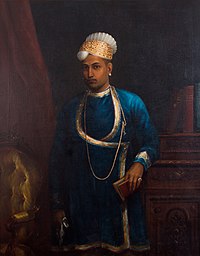Kerala Varma Valiya Koil Thampuran

Kerala Varma Valiya Koil Thampuran
Kerala Varma has been called "a colossal Renaissance figure in 19th century Kerala" and "perhaps the first of the major [Malayalam language] writers who consciously and deliberately began to absorb and celebrate the Western influence" on his native literature. He advocated resuscitation of Malayalam literature by absorbing selected Western influences combined with native Sanskritic elements in poetry, drama and prose.[1]
Life
He was born in
Although the Koil Thampuran was born at Changanacherry, his family subsequently moved to
People from various spheres mourned his death. He was cremated with full state honours at his home in Changanassery.
Literary works
Kerala Varma was in close touch with literary movements in both northern and southern parts of Kerala, including Bhashaposhini Sabha and magazines such as
His work Abhijnana Sakunthalam(1898), a translation of Kalidasa's Sakunthalam, is one of the most acclaimed works of poetry in Malayalam from that period. It influenced a number of other translations of Sanskrit classics into Malayalam and was a success on the stage. The subsequent spate of translations from English and Sanskrit into Malayalam was an important feature of Malayalam literature in the late 19th and early 20th centuries.[1]
He has also written Mayoorasandesham (also spelt Mayura Sandesam; 1894
See also
References
- ^ a b c d e Paniker, Ayyappa, "Modern Malayalam Literature" chapter in George, K. M., editor, ' 'Modern Indian Literature, an Anthology' ', pp 231, 236 published by Sahitya Akademi, 1992, retrieved 10 January 2009
- ^ Sreedhara Menon, A. Cultural Heritage of Kerala. p. 199.
- ^ Pillai, Manu S, ed. (2013), "Valiya Koil Thampuran", The Ivory Throne: Chronicles of the House of Travancore, Harper Collins, p. 67
- Travancore State Manual by Velu Pillai
- Visakhavijaya- A Study by Poovattoor Ramakrishna Pillai
